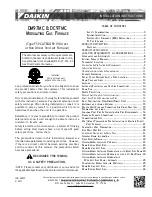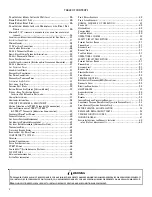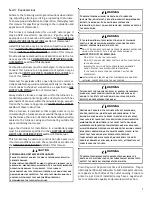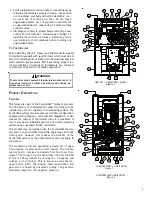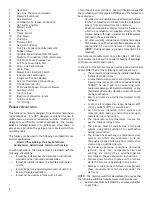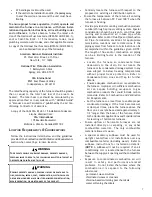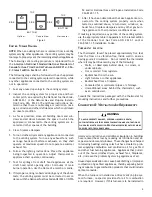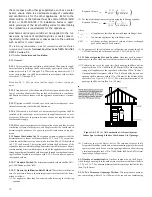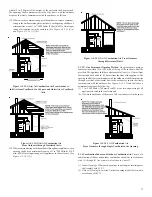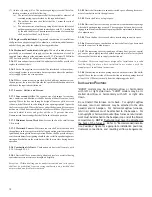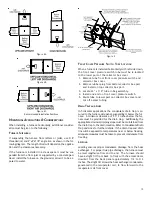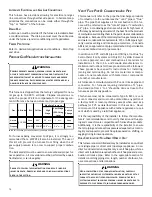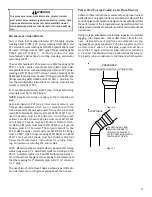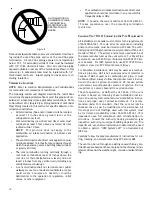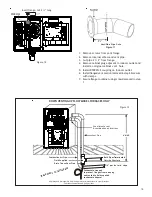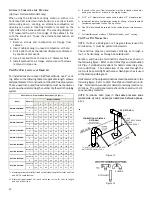
6
This product is dual certified. Dual certification means that
the combustion air inlet pipe is OPTIONAL and the furnace can
be vented as a:
Non-direct vent (single pipe) central forced air furnace
in which combustion air is taken from the installation
area or from air ducted from the outside or,
Direct vent (dual pipe) central forced air furnace in
which all combustion air supplied directly to the
furnace burners through a special air intake system
outlined in these instructions.
•
All other warranty exclusions and restrictions apply
This furnace is an ETL dual-certified appliance and is
appropriate for use with natural or propane gas
(
NOTE:
If using propane, a propane conversion kit is
required).
Gas furnaces manufactured on or after May 1, 2017 are
not permitted to be used in Canada for heating of buildings
or structures under construction.
In the U.S.A. this furnace may be used as a construction site
heater
ONLY
if all of the following conditions are met:
• The vent system is permanently installed per these
installation instructions.
• A room thermostat is used to control the furnace.
Fixed jumpers that provide continuous heating
CANNOT be used and can cause long term
equipment damage. Bi-metal thermostats, or any
thermostat affected by vibration must not be used
during construction.
• Return air ducts are provided and sealed to the
furnace.
• A return air temperature range between 60ºF
(16ºC) and 80ºF (27ºC) is maintained.
• Air filters are installed in the system and
replaced daily during construction and upon
completion of construction.
• The input rate and temperature rise are set
per the furnace rating plate.
• The furnace must be installed as a two pipe
system, using 100% outside air for combustion
during construction.
• The furnace heat exchanger, components, duct
system, air filters and evaporator coils are
thoroughly cleaned following final construction
clean up by a qualified person.
• All furnace operating conditions (including
ignition, input rate, temperature rise and
venting) are verified by a qualified person
according to these installation instructions.
• Furnace doors must be in place on the furnace
while the furnace is operating in any mode.
• Damage or repairs due to failure to comply with
these requirements is not covered under the
warranty.
NOTE:
The Commonwealth of Massachusetts requires that
the following additional requirements must also be met:
•
Gas furnaces must be installed by a licensed plumber
or gas fitter.
1
Gas Valve
2
Gas Line Entrance (Alternate)
3
Pressure Switch(es)
4
Gas Manifold
5
Combustion Air Intake Connection
6
Hot Surface Igniter
7
Rollout Limit
8
Burners
9
Flame Sensor
10
Flue Sensor
11
Flue Pipe
12
Primary Limit
13
Gas Line Entrance
14
Flue Pipe Connection (Alternate) NK
15
Rubber Elbow
16
Variable-Speed Induced Draft Blower
17
Electrical Connection Inlets (Alternate)
18
Coil Front Cover Pressure Tap
19
Coil Font Cover Drain Port
20
Drian Line Penetrations
21
Drain Trap
22
Blower Door Interlock Switch
23
Inductor (Not All Models)
24
Integrated Control Module
25
24 Volt Thermostat Connections
26
Transformer (40 VA)
27
ECM Variable Speed Circulator Blower
28
Auxiliary Limit
29
Junction Box
30
Electrical Connection Inlets
31
Coil Front Cover
32
“H” Fitting
P
RODUCT
A
PPLICATION
This furnace is primarily designed for residential home-heat-
ing applications. It is NOT designed or certified for use in
mobile homes, trailers or recreational vehicles. Neither is it
designed or certified for outdoor applications. The furnace
must
be installed indoors (i.e., attic space, crawl space, or
garage area provided the garage area is enclosed with an
operating door).
This furnace can be used in the following non-industrial com-
mercial applications:
Schools, Office buildings, Churches, Retail stores,
Nursing homes, Hotels/motels, Common or office areas
In such applications, the furnace must be installed with the
following stipulations:
•
It must be installed per the installation instructions
provided and per local and national codes.
•
It must be installed indoors in a building constructed
on site.
•
It must be part of a ducted system and not used in a
free air delivery application.
•
It must not be used as a “make-up” air unit.

